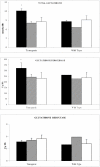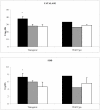Effects of long-term space flight on erythrocytes and oxidative stress of rodents
- PMID: 22412864
- PMCID: PMC3296700
- DOI: 10.1371/journal.pone.0032361
Effects of long-term space flight on erythrocytes and oxidative stress of rodents
Abstract
Erythrocyte and hemoglobin losses have been frequently observed in humans during space missions; these observations have been designated as "space anemia". Erythrocytes exposed to microgravity have a modified rheology and undergo hemolysis to a greater extent. Cell membrane composition plays an important role in determining erythrocyte resistance to mechanical stress and it is well known that membrane composition might be influenced by external events, such as hypothermia, hypoxia or gravitational strength variations. Moreover, an altered cell membrane composition, in particular in fatty acids, can cause a greater sensitivity to peroxidative stress, with increase in membrane fragility. Solar radiation or low wavelength electromagnetic radiations (such as gamma rays) from the Earth or the space environment can split water to generate the hydroxyl radical, very reactive at the site of its formation, which can initiate chain reactions leading to lipid peroxidation. These reactive free radicals can react with the non-radical molecules, leading to oxidative damage of lipids, proteins and DNA, etiologically associated with various diseases and morbidities such as cancer, cell degeneration, and inflammation. Indeed, radiation constitutes on of the most important hazard for humans during long-term space flights. With this background, we participated to the MDS tissue-sharing program performing analyses on mice erythrocytes flown on the ISS from August to November 2009. Our results indicate that space flight induced modifications in cell membrane composition and increase of lipid peroxidation products, in mouse erythrocytes. Moreover, antioxidant defenses in the flight erythrocytes were induced, with a significant increase of glutathione content as compared to both vivarium and ground control erythrocytes. Nonetheless, this induction was not sufficient to prevent damages caused by oxidative stress. Future experiments should provide information helpful to reduce the effects of oxidative stress exposure and space anemia, possibly by integrating appropriate dietary elements and natural compounds that could act as antioxidants.
Conflict of interest statement
Figures




References
-
- Smith SM. Red blood cell and iron metabolism during space flight. Nutrition. 2002;18:864–866. - PubMed
-
- Alfrey CP, Udden MM, Leach-Huntoon CS, Driscoll T, Pickett MH. Control of red blood cell mass in spaceflight. J App Physiol. 1996;81:98–104. - PubMed
-
- Grigoriev AI, Maksimov GV, Morukov BV, Ivanova SM, Yarlikova YV, et al. Investigation of erythrocyte shape, plasma membrane fluidity and conformation of haemoglobin haemoporphyrin under the influence of long-term space flight. J Gravit Physiol. 2004;11:79–80. - PubMed
-
- Voulgaridou GP, Anestopoulos I, Franco R, Panayiotidis MI, Pappa A. DNA damage induced by endogenous aldehydes: current state of knowledge. Mutat Res. 2001;711:13–27. - PubMed
-
- Ghosh N, Ghosh R, Mandal SC. Antioxidant protection: A promising therapeutic intervention in neurodegenerative disease. Free Radic Res. 2011;45:888–905. - PubMed
Publication types
MeSH terms
Substances
LinkOut - more resources
Full Text Sources
Research Materials
Miscellaneous

